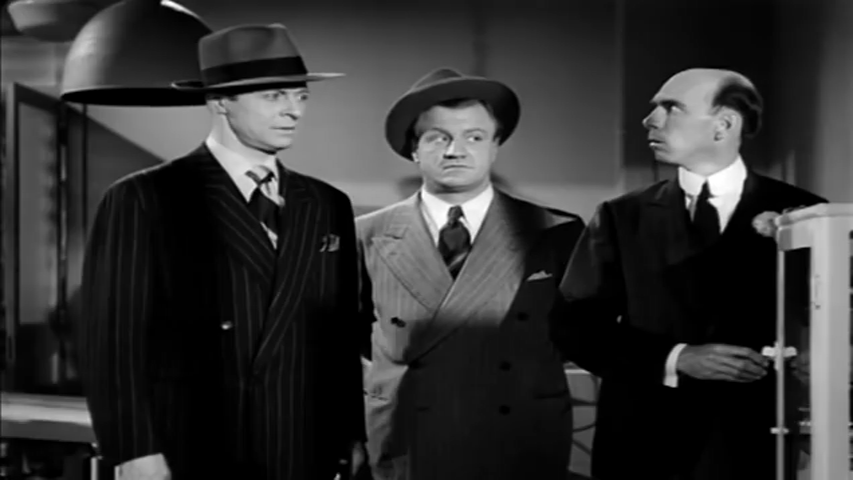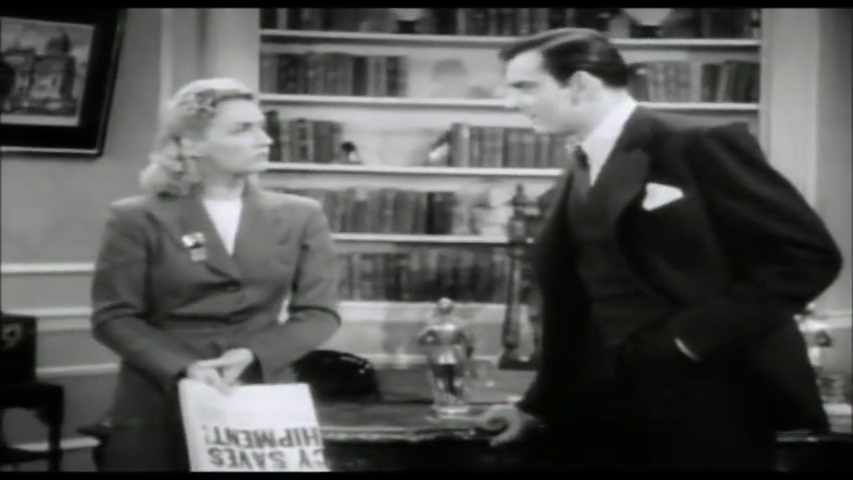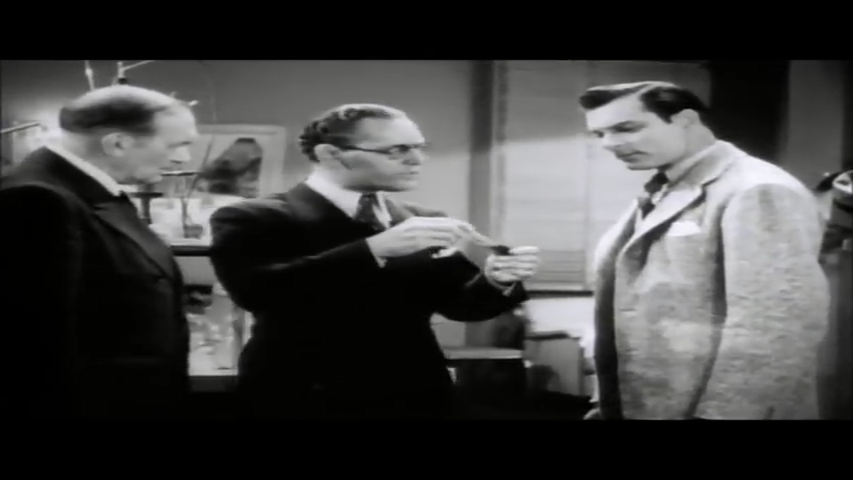-
#387 – Dick Tracy (1945)
Dick Tracy (1945)
Film review #387
Director: William A. Berke
SYNOPSIS: Police detective Dick Tracy is investigating a series of murders carried out by a man calling himself “Splitface”. With plenty of suspects around, Tracy has his hands full trying to apprehend the killer, protect the mayor, and keep his girlfriend Tess happy…
THOUGHTS/ANALYSIS: Dick Tracy is a 1945 film and the first feature film in the Dick Tracy franchise, after the four serials made between 1937 and 1941. The film starts out with a murder of a teacher, which Tracy learns has been carried out by a man calling himself ‘Splitface,’ thanks to a note left by the killer demanding a ransom payment. As the film progresses, a number of suspects emerge, and Tracy must use all of his detective skills to work out who the murderer is. The film fits very much in the crime-noir genre, with the high contrast lighting and dark plot. It also evokes the original comic book style with its dramatic perspectives. The story is certainly more of a faithful adaptation of the comic book than the serials with Tracy being a police detective rather than a G-man as he was in the serials. More of the characters from the comic also make an appearance, which will probably be welcome to readers of the comic (I assume a fair amount of people would have heard of the comics back when the film was released). With each new suspect that emerges, there’s a new element to the plot to be explored, and the pacing is quite consistent with allowing these plot points to keep things from becoming stale or dull. There are some unresolved elements that don’t really go anywhere though, such as Judith Owens being reluctant to discuss where her Father is. With a runtime of just over sixty minutes, the film is quite short, but I think it accomplishes what it wants to do.
As mentioned, a number of characters from the original comic make an appearance, creating a varied and interesting cast. A lot of them also have exuberant appearances or names (Deathridge for the undertaker, for example), which emphasises the comic style. despite the gritty film-noir story, there’s some light-hearted comedy moments which seem more comic-esque, and it feels like the film is trying to pull off both at once, with mixed results. One thing I think the serials did better is the use of science-fiction elements which added something unique, and I think was more in-line with the comics. This film has much more realism, but not so much that it is able to stand out in the film-noir genre. One bizarre scene involves a scientist gleaming into a crystal ball and seemingly hypnotising Tess, but that seems completely out of place, and it was never explored if he really did have the power to hypnotise someone.
This film marks the first time that Dick Tracy is not played by Ralph Byrd, instead by Morgan Conway. The tow look and act very differently, and if you’ve seen the serial you might not like the change. Whereas Byrd’s performance was widely praised as a smooth, charming, action man, Conway is clearly older and lacks that charm, instead seeming a bit goofy at times (although Conway probably looks closer to the character as depicted in the comics). This seems to be a largely held consensus, and led to Byrd reprising the role of Tracy for the third and fourth feature films, as well as the television show. Overall, Dick Tracy is a decent enough crime film, with a mix of action, mystery and some comedy, with a film-noir feel that makes things a little more dramatic, alongside incorporating some more elements of the comics. There’s a clash in tone between a gritty murder drama and the more silly comical aspects, and some plot points which aren’t fully resolved, but it’s an easy and quick watch that holds most of its elements together well.
-
#386 – Dick Tracy vs. Crime, inc.
Dick Tracy vs. Crime, Inc. (1941)
Film review #386
Directors: William Witney, John English
SYNOPSIS: Dick Tracy is assigned to deal with a criminal known only as “The Ghost”, who is able to turn himself invisible thanks to a special invention. The Ghost is after the members of a city crime council, who helped convict his brother Rackets Regan and sentenced him to death. It is a race against time for Tracy to stop The Ghost before he succeeds in killing all the remaining members of the council…
THOUGHTS/ANALYSIS: Dick Tracy vs. Crime, Inc. is a 1941 movie serial and the fourth Dick Tracy serial to be released in as many years. This time, Dick Tracy is on the trail of a master criminal who calls himself “The Ghost,” who also has the power to turn himself invisible thanks to a special machine. The Ghost is seeking to take revenge on the city crime council, who helped convict his brother Rackets Regan to death, and in the opening chapter, we see him take out one of the council members, and his daughter June Chandler, teams up with Tracy in order to stop The Ghost. The story combines two typical tropes of the movie serial format: one, an invisibility device which many serials have done, and two, the identity of the main villain is hidden behind a mask until they are exposed in the final chapter. As always, there’s nothing too unique about the way the serial uses these plot points, but again this Dick Tracy serial manages to use them better than its contemporaries, and create a well balanced serial with plenty of action and intrigue. The added sci-fi element makes it feel a little different from the previous Tracy serials too, which is what is needed in this fourth instalment. There is a fair amount of re-using stock footage from the previous serials for the cliffhangers at the end of each chapter, but honestly it doesn’t feel like that much of a problem, as you know they will always end up with Dick Tracy escaping just in time.
As the serial progresses, there is a range of villainous schemes that Tracy and his friends have to foil, as well as the mystery of The Ghost’s identity with adds an element of mystery to everything. There’s always plenty going on, and the dialogue never gets too dragged down in exposition. For this serial, Dick Tracy is the only returning character, although Billy Carr and June Chandler play the roles of Steve Lockwood, a fellow agent, and Gwen Andrews, Tracy’s secretary in an almost identical capacity. Ralph Byrd as Dick Tracy has always been the star of the serials, and as long as he returns, the rest of the cast are pretty inconsequential. The identity of The Ghost is kept secret throughout the serial, with suspicion falling upon various members of the council at different points, then shifted away as they are killed. Everything is tightly-knit together, and even though it does cut down the cast and re-use some footage, I think it may be the best serial out of them all: it perfects what it is trying to do, and even though it uses plot devices that have been seen in the serial format before, it does them a lot better. If you were going to only see one Dick Tracy serial, I would probably say to choose this one, as it exemplifies not only the best of Dick Tracy, but some of the best examples of the serial format.
-
#385 – Pass Thru (2016)
Pass Thru (2016)
Film review #385
Director: Neil Breen
SYNOPSIS: …I don’t know. An artificial intelligence travels to the present to help guide humanity, who have lost their way with war, crime and corruption. The A.I. takes the body of a drug addict and befriends two migrant children who have escaped smugglers after they cross the U.S. border while it carries out it’s work.
THOUGHTS/ANALYSIS: Pass Thru is a 2016 film. The film is written, directed by and stars Neil Breen, who has a track record for making many of these films single-handed. The film starts off showing some people smugglers getting some people across the U.S. border, and essentially imprisoning them. Meanwhile, a drug addict who helped them is given his payment in the form of drugs and passes out (or dies, I don’t know). Then an A.I. from a thousand years in the future turns up and takes his form…or possesses him? Nothing is really explained here. The A.I. says in one of its many, many monologues that humanity has lost its way through war, corruption and such, and in order to get it back on track he plans to kill about three hundred million people. That’s it. He befriends two of the smuggled migrants who managed to escape, who is converses with in between monologues and visiting corrupt bankers, lawyers and politicians before making them disappear. Oh and there’s a sub-plot with some kids and a professor watching outer space for anomalies or something. This film has little to no coherence or substance, and it obviously focuses on Breen professing his morality. Corruption, war and crime are bad: we already know this, and the film doesn’t really offer any solutions or interesting takes on it, instead just opting to make bad people disappear without showing any real consequence. The mix of monologues and dialogue scenes don’t come together, and all of the other characters don’t really make any contribution, lest they distract from Breen’s holy vision.
The A.I. is revealed to be called “Thgil”, which is obviously “light” backwards, and the film makes a major fuss over it, like it’s a creative revelation or something. Breen’s films always have him in the starring role as a very, very, very, very (very) thinly-veiled Christ figure whose mission is to unveil the corruption and evil in the world and fix it. I can’t help but feel this guy has a complex of some sort. As mentioned, it’s not exactly a revelation that the rich and powerful are corrupt, and war is bad, so I don’t see how this film is going to convert anyone to whatever Breen is trying to sell (kill three hundred million people? I don’t know).
So apart from the story being non-existent, the acting is all awful, and delivered so flatly and without life you can never be immersed in the film because every little gesture and speech sounds forced. The special effects could be done by anyone with a greenscreen and Photoshop, and the most ridiculous effect is the tiger that randomly appears throughout the film for no reason, especially when Breen tries to interact with it. There is also an obsession with drone shots with the film, since Breen clearly just bought one and wanted to fill the film with shots from it. The film might as well be about Breen buying a drone. Overall, Pass Thru is a one-man operation that tries to preach a message you already know. as a film the story is non-existent, the dialogue is forced, the acting is awful and the effects aren’t good enough to be described as amateur. It really does have to be seen to be believed, and might be worth a watch for a laugh if it doesn’t bore you to sleep first.
-
#384 – Dick Tracy’s G-Men (1939)
Dick Tracy’s G-Men (1939)
Film review #384
Directors: William Witney, John English
SYNOPSIS: F.B.I. agent Dick Tracy has successfully captured the international spy Zarnoff, who has been sentenced to death. However, he manages to escape, and picks up where he left off attempting to steal or sabotage military equipment to sell to the ‘three powers’, as Dick Tracy once again tries to stop him.
THOUGHTS/ANALYSIS: Dick Tracy’s G-Men is a 1939 film serial and the third Dick Tracy serial. In the opening, we see a film showing how F.B.I. agent Dick Tracy successfully captured foreign spy Zarnoff, who has now been sentenced to death by gas chamber. While in jail awaiting his sentence however, Zarnoff is sent a newspaper which is laced with a substance which when ingested, causes him to appear dead and stop breathing before he is taken to the gas chamber. While his body is being transferred, members of Zarnoff’s gang hijack the ambulance and steal his body, subsequently reviving him since the substance caused him to stop breathing before he went into the gas chamber, therefore did not breathe in any of the lethal gas (yes, it sounds a bit farfetched). When Dick Tracy learns of Zarnoff’s escape, he again attempts to catch up with him, as Zarnoff has sworn revenge against Tracy. The story, split into fifteen chapters, revolves around (as you would expect) Tracy attempting to foil the numerous schemes of Zarnoff, which, as is a staple of the Dick Tracy serials, outperforms others in the genre by having plenty of variety and imagination, splitting the time between investigation and action scenes. It still sticks rigidly to the serial format, and is essentially more of the same, but its predecessors were popular, so there isn’t really much need to drastically change them. The story around the spy Zarnoff attempting to sell American secrets to the “three powers” would have been more relevant to the time it was released, as World War II had essentially begun, so the theme of spies and espionage would have been particularly poignant, with the “three powers” clearly being a reference to the axis powers.
One more significant change in Dick Tracy’s G-Men was the thinning out of the cast. A number of the characters do not return, including Mike McGurk and Junior, who mostly provided the comic relief, and so the film does feel a bit more serious, again with the back drop of a world war looming. In fact, Ralph Byrd, who plays Dick Tracy, is the only returning actor. Even though the characters Steve Lockwood, a fellow F.B.I. agent, and Gwen Andrews, Tracy’s assistant still show up, they are played by different actors. The character Zarnoff is of particular interest, as he looks like a cross between Stalin and some east-Asian influences, which makes sense given the time of release, and America’s animosity to that area of the world (there were many serials produced around the second World war that utilised a villain that was made to look Chinese or east-Asian).
The pacing of the film is fairly standard, with a new scheme showing up every two or three chapters to keep things interesting, and the standard cliffhanger at the end of each chapter to entice viewers to return to the theatre next week to the next chapter. The ending sees Zarnoff and Tracy crash a plane in the desert, with the two handcuffed together, they are desperate to find water when eventually finding some, Zarnoff knocks Tracy out and uncuffs itself. When Lockwood shows up and finds Tracy, they see that the water contains Arsenic, and shortly find Zarnoff’s body (offscreen) as he has died from ingesting the water. Not exactly a thrilling conclusion, but they never are after investing so much time into these serials they never end on much of a high note. Nevertheless, Dick Tracy’s G-Men is more of the same, but it still maintains a position well above most of the format in terms of action, pacing and characters.
-
#384 – Dick Tracy Returns (1938)
Dick Tracy Returns (1938)
Film review #384
Directors: William Witney, John English
SYNOPSIS: F.B.I. G-man Dick Tracy is on the trail of the Stark family: A criminal gang consisting of “Pa Stark” and his five sons. When new G-man recruit Ron Merton is murdered by the Starks when they hijack a convoy, Tracy swears revenge and attempts to track them down while thwarting their many villainous schemes.
THOUGHTS/ANALYSIS: Dick Tracy Returns is a 1938 film serial and the sequel to the Dick Tracy serial released a year earlier. The story this time revolves around Dick Tracy trying to thwart the criminal enterprises of the Stark family criminal gang, led by Papa Stark and his five sons Champ, Trigger, Dude, Kid and Slasher (great names). The Starks have a range of schemes and crimes they try to carry out, and this gives the serial enough variety to see it through, as Tracy and his team have to stop them across land, sea and air, resulting in an array of chases, as well as some good old-fashioned detective work. The original Dick Tracy serial was a strong mix of serial elements that kept its momentum across its fifteen chapters. Dick Tracy Returns emulates that success and continues it. There’s not much new here, but since the original was a success, there isn’t any need to fix what is not broken. And of course, in an era without repeats on television or home media, it was easier to repeat things on screen as the only way to watch these serials was to go to the theatre every week for the next instalment.
Most of the protagonists from the first serial return with the same actors, which provides a good sense of continuity. The only real change is that a different actor plays Junior, but that’s not much of a distraction. There’s not much character development, but every character has a role to play, from the heroic Dick Tracy and Steve Lockwood, the humour from Mike McGurk, and Tracy’s assistant Gwen, there’s a decent amount of variety in the characters. The villains are also fairly interesting, and showing Tracy stop the individual sons of papa Stark makes the story flow a little easier. Like the first serial, Dick Tracy Returns is a good example of the movie serial format, and has plenty of action, distinguishable characters and thrilling cliffhangers to keep viewers coming back. It’s mostly par for the course for the serial format, but a good example of it.



















































